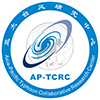International Tropical Cyclone Collaborative Research Guide (2023-2025)
I. Synopsis
The Asia-Pacific Typhoon Collaborative Research Center (AP-TCRC) is a newly-established international joint typhoon research unit located in the Lingang Special Area of Shanghai, China. It is supported by the ESCAP/WMO Typhoon Committee (the Committee) and hosted by the Shanghai Municipal Government of China and the China Meteorological Administration.
The International Tropical Cyclone Collaborative Research Guide provides information on both long-term (1 year, could be extended) and short-term (2-3 months) research areas on tropical cyclones (TCs) to be supported by AP-TCRC. These include TC observing, understanding, modeling and predicting, marine meteorology and related new technologies.
II. Research Areas
a) International tropical cyclone scientific experiment and data analysis in the Asia-Pacific Region
· R&D of new instruments (in situ or remote sensing, automatic or autonomous) and assessment of their applicability in observing TC multi-scale structures, cloud microphysical characteristics, and air-sea interaction processes.
· Analyses of data collected through the field experiments to study physical characteristics associated with TCs.
b) Tropical cyclone modeling
· Development of a fully-coupled air-sea-wave model to study the physical processes related to TC motion and structure (intensity and size) and to improve the forecasts of these elements.
· Evaluation and/or development of parameterization schemes for key physical and chemical processes to improve TC forecasting.
· Development of multi-source TC data assimilation technologies to improve TC forecasting.
c) Application research
· Research on establishing TC-related standards, and compiling data in producing TC climatological atlas products.
· Research on (i) the impact of global warming on the trends of TC activities, (ii) the changing characteristics of catastrophe risks related to TCs, and (iii) response strategies under future climate change.
· Research on TC-induced storm surge models and response strategies, and establishment of a disaster risk and vulnerability evaluation framework related to TCs.
· Development of a TC impact-based model, and enhancement of TC catastrophe risk assessment technologies.
d) International science and technology exchanges and training
· Regular invitation of TC prevention and mitigation personnel to conduct technical training for members of the ESCAP/WMO Typhoon Committee.
· Invitation of international scientists as guest editors of special topics for the international journal Tropical Cyclone Research & Review (TCRR).
· Invitation of top international scientists from different disciplines to work in AP-TCRC on a long-term basis.
· Recruitment of TC researchers from the Asia-Pacific region as guest researchers in AP-TCRC to conduct collaborative research.
· Conduction of international scientific forums to raise the knowledge level of TC forecasters and researchers of members of the ESCAP/WMO Typhoon Committee.
III. Priority Funding Missions for 2024
1 International tropical cyclone scientific experiment and data analysis
1.1 R&D on new instruments suitable for observing TC conditions and applicability assessment.
1.2 Research on the TC’s fine structure and its precipitation and wind effects for megacities.
1.3 Research on the techniques of TC forecasting and climate prediction, including the use of big data.
1.4 Development of Asia-Pacific typhoon data standards, collection and compilation technology, and TC climatological atlas product development.
2 Tropical Cyclone modeling
2.1 Typhoon air-sea coupled model development.
2.2 Parameterization schemes of physical processes adapted to TC conditions.
2.3 Forecast verification methods for the TC model.
2.4 TC data assimilation technology.
3 Disaster defending techniques
3.1 TC-induced inundation model development.
3.2 Research on the TC anomalous characteristics under climate change background.
3.3 Understanding the mechanism of tropical cyclone (TC) and the influence of climate change.
3.4 Seasonal and interseasonal TC forecast techniques.
3.5 The use of Artificial Intelligence in typhoon monitoring and forecasting.
3.6 The forecast techniques of TC in Urban environment.
